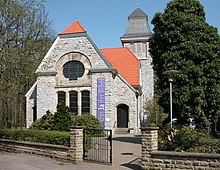Heinrich Plange
Heinrich Plange (born June 17, 1857 in Elberfeld (now part of Wuppertal ), † July 5, 1942 in Wetter an der Ruhr ) was a German architect who created sacred and secular buildings .
Life
Heinrich Plange was the sixth among eight children of Wilhelm Plange . In 1878 he began studying architecture with Julius Carl Raschdorff at the Technical University (Berlin-) Charlottenburg . In the years 1878 to 1880 Plange wrote many of the theses that have survived to this day. Later studies show a stylistic similarity to the Italian Renaissance. After finishing his studies, he went on a study trip to Italy. He initially worked as a government master builder ( assessor ) in state construction, at the latest in 1890 he returned to his home town of Elberfeld and started his own business . As a partner in the company Plange und Hagenberg , he managed a construction engineering office; the second partner was Friedrich Hagenberg , Plange is to be seen as the authoritative draftsman within the office. After this partnership was dissolved, Plange continued to run the office alone until 1921.
On June 11, 1891, he married Elisabeth Brandhoff, they had three children together. During the First World War, his two sons fell and his wife died. In 1918 Plange moved to Gruiten with his daughter . In 1932 both went to Wetter an der Ruhr, where they lived until Heinrich Plange's death.
Buildings and designs
Plange designed six churches that were built between 1889 and 1911, including:
- 1899–1901: Evangelical Christ Church in Elberfeld
- 1903–1904: Protestant Neander Church in Erkrath-Hochdahl
The following are worth mentioning about manufacturers' villas:
- 1891–1893: Villa von der Heydt in Bad Godesberg
- 1897–1899: Villa Seyd in Elberfeld
- 1902 : Landfried's house for Peter Lucas Colsman in Langenberg
- 1902–1903: Villa Baum (also "Villa Boltenberg") in Elberfeld
- 1904 : Villa Cappell in Bad Godesberg
- 1905–1907: Plange house in Elberfeld (inhabited by Plange until 1918)
- 1911 : Noetzlin House in Elberfeld
- 1913–1914: Villa Plange in Hamburg , Elbchaussee 43
literature
- Axel Kirchhoff: The architect Heinrich Plange (1857–1942). Dissertation, Bergische Universität Wuppertal, 2004. ( as electronic publication on the Bergische Universität Wuppertal website )
Web links
| personal data | |
|---|---|
| SURNAME | Plange, Heinrich |
| BRIEF DESCRIPTION | German architect |
| DATE OF BIRTH | June 17, 1857 |
| PLACE OF BIRTH | Elberfeld |
| DATE OF DEATH | July 5, 1942 |
| Place of death | Weather on the Ruhr |
